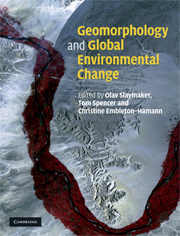Book contents
- Frontmatter
- Contents
- List of contributors
- Preface
- Acknowledgements
- List of acronyms and abbreviations
- 1 Landscape and landscape-scale processes as the unfilled niche in the global environmental change debate: an introduction
- 2 Mountains
- 3 Lakes and lake catchments
- 4 Rivers
- 5 Estuaries, coastal marshes, tidal flats and coastal dunes
- 6 Beaches, cliffs and deltas
- 7 Coral reefs
- 8 Tropical rainforests
- 9 Tropical savannas
- 10 Deserts
- 11 Mediterranean landscapes
- 12 Temperate forests and rangelands
- 13 Tundra and permafrost-dominated taiga
- 14 Ice sheets and ice caps
- 15 Landscape, landscape-scale processes and global environmental change: synthesis and new agendas for the twenty-first century
- Index
8 - Tropical rainforests
Published online by Cambridge University Press: 05 July 2015
- Frontmatter
- Contents
- List of contributors
- Preface
- Acknowledgements
- List of acronyms and abbreviations
- 1 Landscape and landscape-scale processes as the unfilled niche in the global environmental change debate: an introduction
- 2 Mountains
- 3 Lakes and lake catchments
- 4 Rivers
- 5 Estuaries, coastal marshes, tidal flats and coastal dunes
- 6 Beaches, cliffs and deltas
- 7 Coral reefs
- 8 Tropical rainforests
- 9 Tropical savannas
- 10 Deserts
- 11 Mediterranean landscapes
- 12 Temperate forests and rangelands
- 13 Tundra and permafrost-dominated taiga
- 14 Ice sheets and ice caps
- 15 Landscape, landscape-scale processes and global environmental change: synthesis and new agendas for the twenty-first century
- Index
Summary
The tropical rainforest ecological and morphoclimatic zone
This chapter focusses on the likely geomorphological impacts of global warming on the zone with a hot – wet climate covered or formerly covered by tropical rainforest. Defined by Schimper (1903, p. 260) as ‘Evergreen, hygrophilous in character, at least 30 m high, but usually much taller, rich in thick-stemmed lianes and in woody as well as herbaceous epiphytes’, tropical rainforest represents the vegetational climax of the ever-wet tropical zone (Richards, 1996). It is the biome renowned for its very high species diversity, high biological productivity, continuity of existence extending back to the early Cretaceous (Morley, 2000) and its pivotal role (depending upon how much of it survives) in influencing the future of the world climatic system. Climatic diversity within the zone, a history of climate change and the profound influences which tectonic history and lithology exert within the region mean that old simplistic ideas about a humid tropical morphoclimatic region have been largely discounted (Thomas, 1994; 2006). This chapter, therefore, adopts a modified climatic geomorphological approach, which stresses:
(a) the distinctiveness of some climate-linked features of the tropical rainforest zone;
(b) the influence of diversity in geomorphologically important climatic and bioclimatic variables within the zone;
(c) the influence of climate change and sequences of climate at many different timescales; and
(d) the acute sensitivity of many of its processes, landforms and landscapes to combinations of human activities and climate change.
The importance of changes in extremes as well as means of climate is emphasised. This opening section summarises the main features (including diversity) of geomorphic significance of the climates, vegetation and soils of the zone and the long-term history of the forest biome in relation to climate change. The second section reviews geomorphological processes and landforms within the ever-wet tropics, including the impact of human activities, before later sections consider predicted climate change by the end of the twenty-first century for the zone and the likely geomorphological consequences.
- Type
- Chapter
- Information
- Geomorphology and Global Environmental Change , pp. 214 - 247Publisher: Cambridge University PressPrint publication year: 2009
- 6
- Cited by

